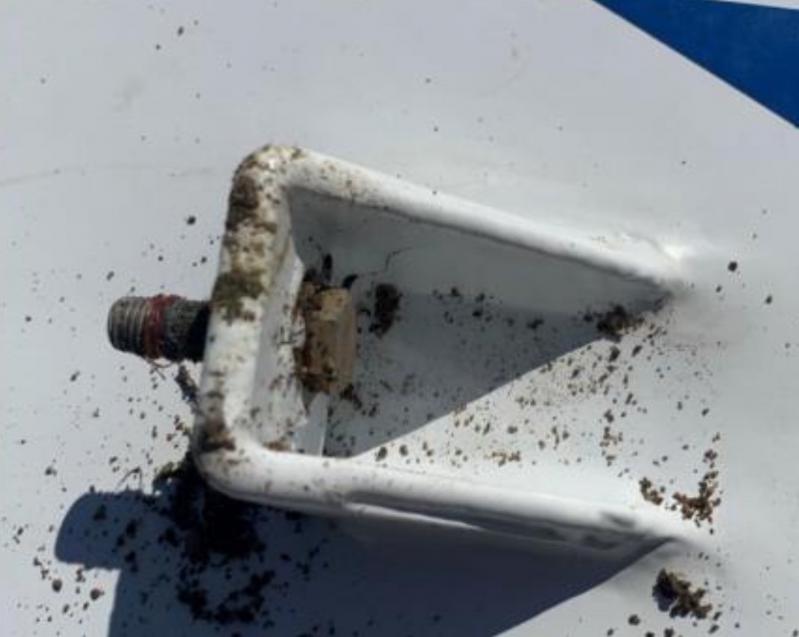A photograph of a dirt-spattered bolt without a nut was highlighted in a National Transportation Safety Board preliminary report on Kent Feuerring’s fatal seaplane crash in the early afternoon of Oct. 6.
“View of right-wing strut attachment bolt as found” reads the caption in the photograph.
Heidi Kemner, the investigator in charge of the report, noted that the engine was largely intact, and that the propeller remained attached to the engine.
The struts attaching the wings were carefully described. Ms. Kemner wrote: “The left-wing strut was impact separated from the wing and the strut attach point bolt remained secure with the nut.” That contrasts with the report on the right wing, which states, “The right wing strut was separated from the right wing. The bolt attaching the right strut to the right wing remained attached to the right wing and was not fractured; however, the nut was not present. In addition, the bolt threads did not exhibit significant damage.”

The fact that the threads were not damaged could indicate the nut was not on the bolt at the start of the flight.
Mr. Feuerring’s accident was not the first of its kind for a Seamax M-22. In February of 2021, the right wing separated from another Seamax M-22 in Italy, shortly after takeoff, causing the plane to crash and killing its pilot.
The Seamax M-22 is an amphibious light-sport aircraft with wings that are designed to fold so it can be transported. On its website, it is displayed in a few feet of calm water, canopy open.
“From lakes to sprawling fields or secluded Caribbean lagoons, the M-22 is a Seamax of outstanding class, delivering adventure so intensely felt that it demands to be experienced again and again,” reads the pitch.
Its listing price is $189,400.
The plane was registered to N46PD, a limited liability company at 300 Pantigo Place, Suite 102, which matches the address for the Sabin Metal Corporation. A person going by the name “Flyfox” claiming to be a co-owner of the plane, commented on a pilotsofamerica forum that “The wings have NEVER been folded since it was assembled by Seamax and certified by the F.A.A. in Florida in early April 2022.” In the same post, Flyfox wrote that they had purchased the fixed-wing version of the plane, but that Seamax had delivered the folding wing version.
Since the plane was to be kept in a hangar at East Hampton Airport, Flyfox said they had no need to transport and fold the wings of the plane.
“The plane was flown by this pilot from FL to NY with a specialized instructor who spent a week here training the pilots on every detail of flying this aircraft,” he wrote. A 50-hour flight inspection had been done during the summer and “On the day of the crash, Seamax’s head engineer was on a plane en route to the area to perform the 100-hour inspection the next day.”
Visibility was 10 miles on Oct. 6, the wind was light from the northwest, and it was 66 degrees. Mr. Feuerring flew only 4.5 miles before the wing dislodged, sending the aircraft spiraling down into a few feet of water in the southernmost section of Three Mile Harbor.
“This wing did not fall off due to any lack of diligence or action by the owner or pilot,” Flyfox asserted.
Mr. Feuerring’s actions were detailed in the report. He arrived at the airport at 11:59 a.m. By 12:06 p.m., he had removed the Seamax from the hangar and two minutes later, had finished performing a pre-flight inspection. He entered the plane and started the engine at 12:09 p.m.
Once on, the plane began automatically transmitting its positional data to the airport via its Preliminary Automatic Dependent System (ADS-B). By 12:14 p.m. Mr. Feuerring was taxiing, and the wheels of the airplane left the runway at 12:19 p.m. He flew south over the ocean near Wainscott, turned east, and then back north.
A witness heard the plane flying over, which drew his attention before he heard a loud “crack, and saw a wing separate from the plane.” The ADS-B data was knocked out shortly after the plane entered the airspace over Three Mile Harbor.
The separated wing landed in a tree 770 feet away from the main plane wreckage. The rest of the plane hit the harbor water and exploded.
The plane had been flown without incident only a week before, on Sept. 30. It was not clear if Mr. Feuerring was the pilot on that day.
“Hopefully the NTSB will be able to shed light on several questions, including why a critical bolt at the strut/wing attachment was found with no nut and no damage to the threads. We will just have to be patient for their final report,” wrote Flyfox.
Mr. Feuerring, who was 57, was an experienced pilot who was president of the East Hampton Aviation Association. Friends and fellow pilots described him as careful and meticulous.


